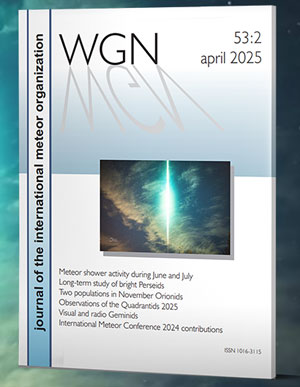January sees a peak of sporadic activity for the
southern hemisphere while rates seen north of the equator begin a steady downward
turn that continues throughout the first half of the year. The sporadic activity
is good for both hemispheres, but not as good as it was for northern observers in
December. Once the Quadrantids have passed the shower activity for January is very
quiet.
During this period the moon reaches its last
quarter phase on Thursday January 11. During this entire period the moon will
rise during the evening hours and will interfere with observing during the most
productive morning hours. The sources of meteors listed below are active during
this period but will be difficult to observe this week. If your sky is transparent
and the limiting magnitude exceeds +5.0, then you may be able to achieve some
success. The estimated total hourly rates for evening observers this week is near
three no matter your location. For morning observers the estimated total hourly rates should
be near five no matter your location. These rates assume that you are watching from rural
areas away from all sources of light pollution. The actual rates will also depend
on factors such as personal light and motion perception, local weather conditions,
alertness and experience in watching meteor activity. Rates are reduced this week
due to intense moonlight.
The radiant positions listed below are exact for Saturday
night/Sunday morning January 6/7. These positions do not change greatly day to day
so the listed coordinates may be used during this entire period. Most star atlases
(available at science stores and planetariums) will provide maps with grid lines
of the celestial coordinates so that you may find out exactly where these positions
are located in the sky. A planisphere or computer planetarium program is also useful
in showing the sky at any time of night on any date of the year. Activity from each
radiant is best seen when it is positioned highest in the sky, either due north or
south along the meridian, depending on your latitude. It must be remembered that
meteor activity is rarely seen at the radiant position. Rather they shoot outwards
from the radiant so it is best to center your field of view so that the radiant lies
at the edge and not the center. Using this method will allow you to easily trace the path
of each meteor back to the radiant (if it is a shower member) or in another direction
if it is a sporadic. Meteor activity is not seen from radiants that are located
below the horizon. The positions below are listed in a west to east manner in
order of right ascension (celestial longitude). The positions listed first are
located further west therefore are accessible earlier in the night while those
listed further down the list rise later in the night.
The full descriptions of each active meteor shower will continue next week when
the moon becomes less of a nuisance to observers.
| SHOWER | DATE OF MAXIMUM ACTIVITY | CELESTIAL POSITION | ENTRY VELOCITY | CULMINATION | HOURLY RATE | CLASS* | RA (RA in Deg.) DEC | Km/Sec | Local Standard Time | North-South | Antihelion (ANT) | – | 07:56 (119) +20 | 30 | 01:00 | 1 – <1 | II | Coma Berenicids (COM) | Dec 20 | 12:44 (191) +18 | 65 | 05:00 | 1 – <1 | II |




 You saw something bright and fast? Like a huge shooting star? Report it: it may be a fireball.
You saw something bright and fast? Like a huge shooting star? Report it: it may be a fireball.  You counted meteors last night? Share your results with us!
You counted meteors last night? Share your results with us!  You took a photo of a meteor or fireball? You have a screenshot of your cam? Share it with us!
You took a photo of a meteor or fireball? You have a screenshot of your cam? Share it with us!  You caught a meteor or fireball on video? Share your video with us!
You caught a meteor or fireball on video? Share your video with us!